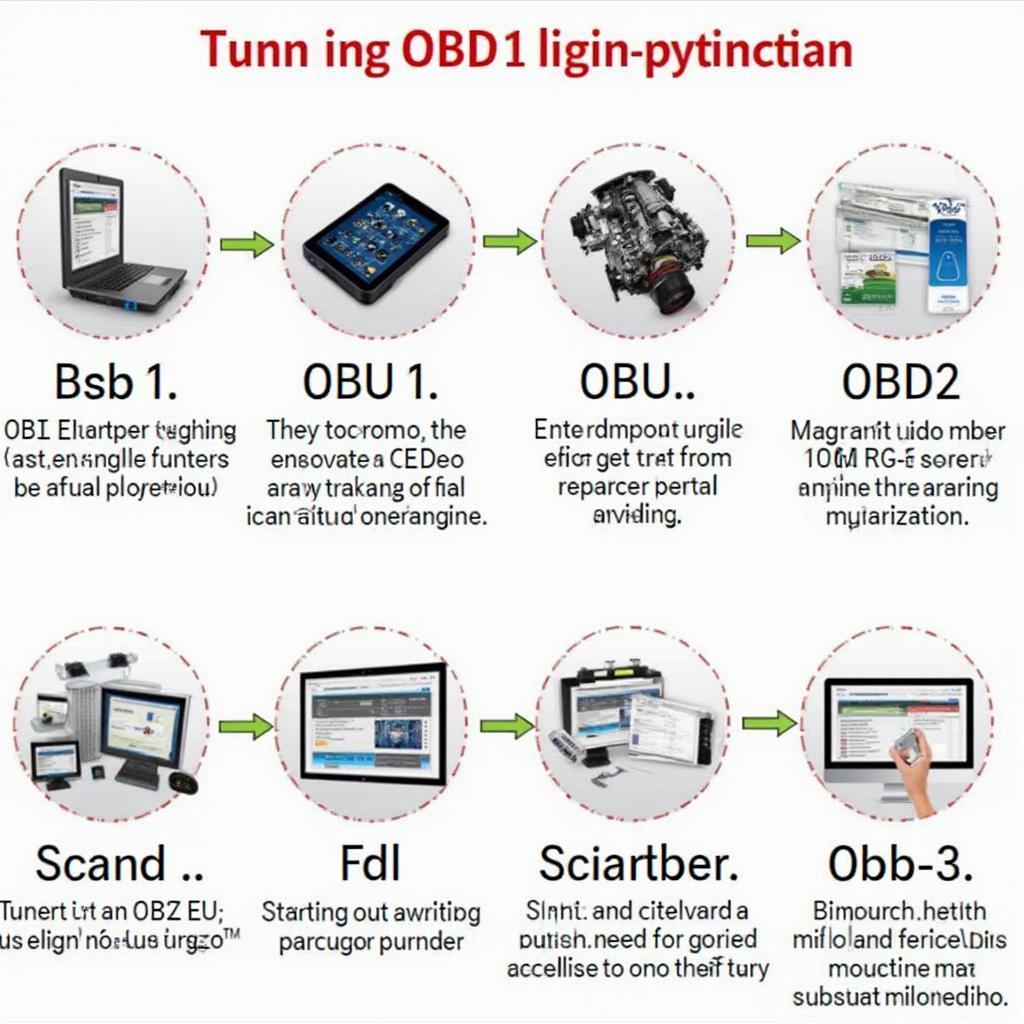Your cart is currently empty!

OBD1 ECU on OBD2 Motor: A Comprehensive Guide
Using an OBD1 ECU on an OBD2 motor is a common modification, especially among car enthusiasts seeking specific tuning capabilities or looking to simplify their engine management systems. This article will delve into the intricacies of this conversion, exploring the benefits, challenges, and crucial steps involved in successfully integrating an OBD1 ECU with an OBD2 engine.
Many car enthusiasts consider the OBD1 system more straightforward for tuning and troubleshooting. However, understanding the key differences between OBD1 and OBD2 systems is paramount before attempting this conversion. An obd2 motor has a more complex emissions control system and utilizes a different communication protocol than its OBD1 counterpart. This means adapting the wiring harness and potentially modifying various sensors to ensure compatibility.
Understanding the Differences: OBD1 vs. OBD2
OBD1 systems, generally found in vehicles manufactured before 1996, rely on a simpler diagnostic protocol and often offer more direct control over engine parameters. OBD2, introduced in 1996, features a standardized diagnostic connector and more sophisticated emissions monitoring. This difference necessitates careful planning and execution when using an obd1 ecu with obd2 distributor.
Why Choose an OBD1 ECU on an OBD2 Engine?
Despite the added complexity, there are several reasons why someone might opt for an OBD1 ECU on an OBD2 motor:
- Simplified Tuning: OBD1 systems are often preferred by tuners for their relative simplicity, allowing for more direct control over fuel and ignition maps.
- Cost-Effectiveness: In certain cases, sourcing an OBD1 ECU and adapting it can be more economical than purchasing a standalone engine management system.
- Legacy Support: For older project cars or race cars, an OBD1 setup may offer better compatibility with existing components.
 OBD1 ECU on OBD2 Engine: Wiring Harness Adaptation
OBD1 ECU on OBD2 Engine: Wiring Harness Adaptation
Key Considerations for the Conversion
Successfully integrating an OBD1 ECU onto an OBD2 motor requires addressing several key areas:
- Wiring Harness Modifications: The wiring harnesses of OBD1 and OBD2 systems are different. You’ll need to carefully adapt the OBD1 harness to connect to the OBD2 engine’s sensors and actuators.
- Sensor Compatibility: Some sensors, like the oxygen sensor and coolant temperature sensor, may have different output characteristics between OBD1 and OBD2. Ensure compatibility or consider using appropriate adapters.
- Distributor Compatibility: Using an honda obd2 to obd1 distributor conversion often necessitates changes to the distributor and ignition system to match the OBD1 ECU.
- Emissions Compliance: Be aware that converting to an OBD1 system might affect your vehicle’s emissions compliance, especially if you live in an area with strict emissions regulations.
What about the distributor?
The distributor plays a critical role in ignition timing. Using the correct distributor for your OBD1 ECU is essential.
“Choosing the correct distributor is paramount,” says renowned automotive engineer, Dr. Michael Carter. “Mismatched components can lead to timing issues and significantly impact engine performance.”
Tuning and Calibration
Once the hardware is in place, proper tuning and calibration are essential to optimize engine performance. This often involves adjusting fuel and ignition maps to match the specific characteristics of the engine and modifications. Understanding ignition timing advance for 1 cylinder obd2 can be crucial for fine-tuning performance. Additionally, using an obd1 and obd2 program can help with the tuning process.
Common Pitfalls to Avoid
- Improper Wiring: Incorrect wiring can lead to a range of issues, from sensor malfunctions to complete engine failure. Double-check all connections and refer to wiring diagrams specific to your application.
- Ignoring Sensor Compatibility: Using incompatible sensors can provide inaccurate readings to the ECU, resulting in poor performance and potential damage.
- Lack of Proper Tuning: Failing to properly tune the engine after the conversion can lead to suboptimal performance and potential engine damage.
“Thorough research and meticulous execution are crucial,” advises automotive electronics specialist, Susan Miller. “Overlooking seemingly minor details can lead to significant problems down the road.”
 Tuning an OBD1 ECU on an OBD2 Engine
Tuning an OBD1 ECU on an OBD2 Engine
Conclusion
Running an OBD1 ECU on an OBD2 motor offers potential benefits, but requires careful planning and execution. Understanding the key differences between the two systems, addressing compatibility issues, and meticulously performing the conversion are critical for success. By addressing these aspects, you can harness the advantages of an OBD1 system while maintaining the reliability and performance of your OBD2 motor.
FAQ
- Is it legal to run an OBD1 ECU on an OBD2 motor? This depends on local emissions regulations. Check your local laws.
- What are the main advantages of using an OBD1 ECU? Simplified tuning and potential cost savings are key benefits.
- What are the challenges of this conversion? Wiring harness adaptation and sensor compatibility are common challenges.
- Do I need to modify my distributor? Often, yes. Distributor compatibility is crucial.
- How do I tune an OBD1 ECU? Specialized software and tuning tools are required.
- What are the common pitfalls to avoid? Improper wiring, sensor incompatibility, and lack of proper tuning.
- Where can I find more information? Online forums and automotive communities can provide valuable insights.
Common Scenarios
- Swapping an OBD2 engine into an older vehicle with an OBD1 system.
- Converting a vehicle to a standalone engine management system using an OBD1 ECU.
- Modifying a race car for performance optimization using an OBD1 ECU.
Further Exploration
Consider researching topics such as OBD1 and OBD2 diagnostics, engine tuning principles, and wiring harness modifications for further understanding.
For support, contact us via WhatsApp: +1(641)206-8880, Email: [email protected] or visit us at 789 Elm Street, San Francisco, CA 94102, USA. Our customer support team is available 24/7.

Leave a Reply